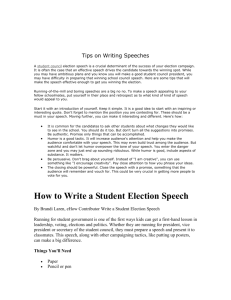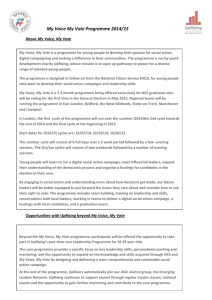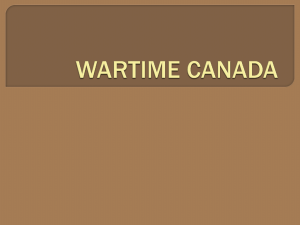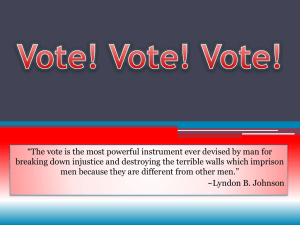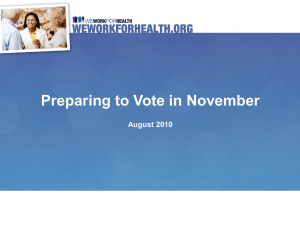5. Stone
advertisement
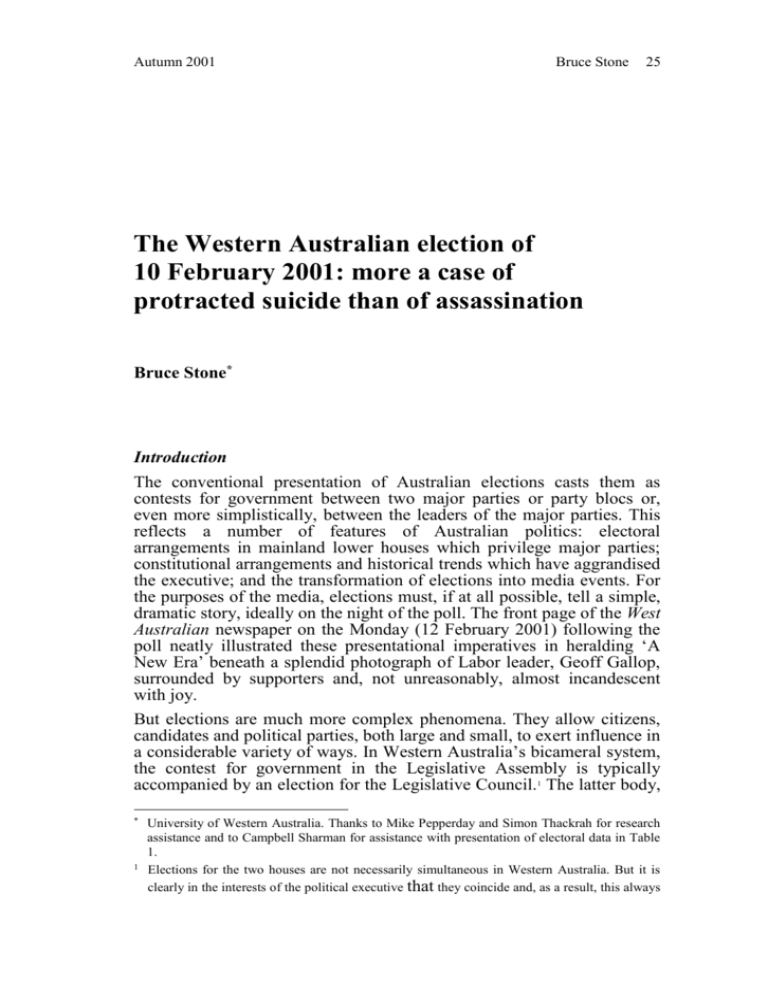
Autumn 2001 Bruce Stone 25 The Western Australian election of 10 February 2001: more a case of protracted suicide than of assassination Bruce Stone* Introduction The conventional presentation of Australian elections casts them as contests for government between two major parties or party blocs or, even more simplistically, between the leaders of the major parties. This reflects a number of features of Australian politics: electoral arrangements in mainland lower houses which privilege major parties; constitutional arrangements and historical trends which have aggrandised the executive; and the transformation of elections into media events. For the purposes of the media, elections must, if at all possible, tell a simple, dramatic story, ideally on the night of the poll. The front page of the West Australian newspaper on the Monday (12 February 2001) following the poll neatly illustrated these presentational imperatives in heralding ‘A New Era’ beneath a splendid photograph of Labor leader, Geoff Gallop, surrounded by supporters and, not unreasonably, almost incandescent with joy. But elections are much more complex phenomena. They allow citizens, candidates and political parties, both large and small, to exert influence in a considerable variety of ways. In Western Australia’s bicameral system, the contest for government in the Legislative Assembly is typically accompanied by an election for the Legislative Council.1 The latter body, * 1 University of Western Australia. Thanks to Mike Pepperday and Simon Thackrah for research assistance and to Campbell Sharman for assistance with presentation of electoral data in Table 1. Elections for the two houses are not necessarily simultaneous in Western Australia. But it is clearly in the interests of the political executive that they coincide and, as a result, this always 26 WA election 2001 APR 16(1) in which minor parties have controlled the balance of power in recent years, plays an important and growing role in the Western Australian legislative process and in the processes of executive accountability. Minor parties and their supporters may also influence lower house elections, where single member constituencies typically deny them representation, through decisions about preferences under the ‘alternative vote’ system. This has been a topic of great interest following the 2001 Western Australian state election, with much speculation about the role of the One Nation party in bringing about a change of government. This commentary seeks to place the Western Australian election in the context of recent electoral history, the performance of the Court government and the campaign, before presenting and interpreting the results. Context of the 2001 election: accumulating negatives for the government The 2001 election represented the incumbent Liberal-National Coalition Government’s effort to win a third four-year term. There has been much talk about voter unwillingness of late to give such continued support to governments and the Western Australian election does nothing to dispel that view. But the argument of this commentary is that the government also made a sustained contribution to its own demise. The Coalition had ridden to office in 1993 on the back of widespread disaffection with a discredited, decade-old Labor administration. Leadership changes and policy responses to the damaging ‘WA Inc’ Royal Commission of 1992 were ultimately unsuccessful in distancing Labor, under Carmen Lawrence, from the administrations of Burke and Dowding. The Liberal-National Coalition emerged from the 1993 election with a 7 seat majority, based on 49.46 per cent of the first preference vote, in the 57 seat Legislative Assembly. In 1996, the Coalition increased its majority to 13 seats, following a campaign which focussed heavily for a second time on the maladministration of the ‘WA Inc’ years. There were some signs of elector weariness with the Liberaldominated government in the drop of more than 4 per cent in the Liberal primary vote. But at this point there was little sign of a Labor revival, with a further decline in that party’s share of the vote. The gains were made by minor parties and independents, a sign of things to come. The results of these earlier elections are presented in Table 1 below. The Coalition Government under Premier Richard Court was a good deal more conservative than the Kennett Government elected four months earlier in Victoria, with which it was inevitably compared early on. One of Court’s campaign slogans had been ‘I’m no Jeff Kennett’. And while the Government pushed forward with a program of industrial relations occurs. Since 1987, when rotation membership was abolished, Legislative Council elections have been for the whole house. Autumn 2001 Bruce Stone 27 reform, debt reduction, privatisation and contracting out, the policies were less radical in substance and presentation. Nevertheless, privatisation and especially the massive shift to the contracting of public sector functions created some disquiet, perhaps especially in rural areas. Outside Perth, as elsewhere in rural Australia, a variety of threats to standards of service provision (in such matters as health, roads and rail freight) along with petrol prices are currently major sources of political disaffection. Court was widely perceived as likeable, fair and honest. But a theme throughout his leadership was his half-hearted embrace of the very wideranging administrative and institutional reform program to promote greater openness and accountability in government, promulgated with great media publicity by the ‘WA Inc’ Royal Commission and the follow-up Commission on Government which released its series of reports from late 1995 to late 1996. Court’s not inconsiderable reforms in this area were typically perceived as grudgingly introduced and meagre when compared with the benchmarks established by the two commissions of inquiry. Something similar occurred with the most prominent environmental issue in Western Australia over the past several decades, the logging and woodchipping of the state’s remnant old-growth forest. Under the weight of public opinion, the Government backed down from the Regional Forest Agreement in July 1999 and adopted a significantly greener position on the logging of old-growth forest. But it failed to reap any political credit for a policy change which appeared ad hoc, reactive and transparently calculating. Its opponents, by no means mollified by the backdown, had read better the public’s desire, after many years of skilful agitation by green groups, for a complete and immediate end to logging in old growth forest. The Government was faced not only with an Opposition articulating the popular radical position, but was also under attack from figures within Perth’s social elite, many claiming past associations with the Liberal Party. Some of these individuals, styling themselves Liberals for Forests, were to campaign effectively against Liberal members of parliament in the lead up to the February election. Finally, Court’s conservatism, softness, or weakness (there are different views) was manifested, harmfully for his government’s standing, in his persistent unwillingness to remove ministers who were performing poorly. The most damaging instance concerned Doug Shave, the Minister for Fair Trading, who presided over a regulatory regime which permitted dishonest mortgage finance brokers to defraud many senior citizens of large sums of money. The events, prominently reported in the local press, began to unfold in February 1999 and by the end of the year had become a scandal. A public inquiry in early 2000 did little to stem the flow of criticism of the government, which continued right up to the election. A strong impression was created in the community that the minister had been, at the least, insufficiently interventionist in the affairs of his portfolio. His refusal to accept liability for the maladministration and 28 WA election 2001 APR 16(1) resign, and the Premier’s refusal to sack him, reinforced the view that the Government was arrogant and unconcerned with accountability. Campaign: more government stumbles In the current era of declining party identification and voter volatility, election campaigns are more important than ever. But such is the level of voter disengagement from politics that increasing numbers of electors make up their minds about how to cast their votes only in the last days of the campaign.2 The announcement of the election date on 10 January, allowing only a month for the official campaign, was tailored to the diminishing tolerance and attention span of the modern electorate. So, too, was the scheduling of the major parties’ official launches towards the end of the campaign, the Liberals on 28 January and the ALP on 4 February (only six days before the election). The campaigns, out of the contemporary textbook for major parties, featured the two leaders moving at lightening speed around the state announcing rafts of policies and accusing each other of financial profligacy. There was a set piece television ‘debate’, in which the two leaders showcased their genuinely decent and engaging natures and their policy directions; Gallop emphasising his commitment to confront problems with basic services (health, education, drugs, law and order) and Court his fiscal rectitude and his record of generous expenditure and policy innovation in the same service areas. The television debate highlighted an emerging problem for the Government in the campaign. The proudest achievement of the Government, in particular Court as Treasurer, was its claim to excellence in financial management following its predecessor’s woeful record in this field. Court clearly believed that this virtue overrode any of his Government’s failings: his was the administration which had returned the state’s budget to surplus, dramatically reduced debt and restored the State’s AAA credit rating. Underlining the Government’s emphasis on fiscal accountability, one of its admirable innovations was to require that the Treasury publish details of the State’s financial position, including forward estimates, in the pre-election period. Unfortunately for the Government, the Treasury’s analysis provided support for the Opposition’s claim that the Government was presiding over a deteriorating budgetary position, with a potential return to persistent deficits. Court handled the issue clumsily in the television debate and elsewhere, simply stonewalling in response to persistent media questioning. Thus was dented the government’s strongest claim to office. In the final week of the campaign, with voters now as tuned in as they were ever going to be, there occurred an incident which reinforced qualms about the Government’s commitment to openness and 2 A week before the election, a poll published in the West Australian newspaper (3/2/01) revealed 13 per cent of voters remained undecided. Autumn 2001 Bruce Stone 29 accountability. It was revealed that Liberal backbencher, Bob Bloffwitch, owned a package of shares in a company interested in developing a steel mill in his Geraldton electorate. He had not listed the shares on an official register of financial interests, as required by the Parliament, despite heading the parliamentary Privileges Committee which administers the register of members’ interests. It was further revealed that he had lobbied to promote the interests of Kingstream Steel and against alternative developments in the town of Geraldton. Court was, once more, reluctant to condemn a parliamentary ally, adding to the already well established perception of a government which believed it could brazen its way out of allegations of impropriety or maladministration. Framing all of these aspects of the campaign was the Government’s addiction to a strategy of tarring the Opposition with the ‘WA Inc’ brush, which it had successfully employed in the previous two elections. The government parties were aware that this ploy had lost some of its potency after eight years of Coalition Government, and sought to bolster it with standard references to union domination of the Labor Party. An additional negative theme, with appeal in rural Western Australia, was the danger posed to rural representation by Labor’s commitment to ending malapportionment in the State’s electoral system. There is no doubt that negative campaigning is a legitimate tool and, in the right circumstances, an effective one in democratic politics. And, given Labor’s poor primary vote on February 10, it may well have borne some fruit. On the other hand, the negative flavour of the Liberal campaign in particular may have helped to create an impression of a desperate party bereft of positive appeal. In short, the campaign did little to alter the growing perception of a lacklustre government, doing its fair share to assist its electoral enemies. This was reflected in newspaper polls during the campaign, which revealed badly sagging support for the governing parties. This is the essential background for an understanding of the election results. The Coalition was ripe for the plucking and there were no shortage of eager pluckers. Results By the last couple of days of the campaign, Liberal polling had clearly revealed massive support for minor parties and independents and Court was appealing, rather feebly, for preferences. He would have realised he had little prospect of getting them from the swelling support for Greens (WA), but might have hoped that sufficient One Nation voters, emerging in large numbers, would defy their party’s efforts to direct them to allocate preferences against sitting candidates in all but a handful of Assembly seats. But, by this stage, he was a drowning man clutching at straws. 30 WA election 2001 APR 16(1) Table 1 Results of Western Australian State Elections in 1989, 1993, 1996 and 2001 Vote share and seats won 1989 First Seats Preference vote % n 1993 First Seats preference vote % n 1996 First Seats preference vote % n 2001 First Seats preference vote % n Legislative Assembly Liberal ALP National Democrat Greens One Nation Other 42.8 42.5 4.6 1.4 0.3 44.2 37.1 5.3 2.3 4.3 26 24 6 39.9 35.8 5.8 5.1 4.7 29 19 6 6.8 11 8.7 32 45.6 36.8 4.0 3.0 5.2 15 14 3 1 45.9 33.1 04 6.6 5.6 14 12 3 2 3 5.4 1 8.9 3.6 Legislative Council Liberal 41.1 ALP 41.3 National 5.0 Democrat 3.3 Greens 1.9 One Nation Other 7.4 Notes 20 31 6 15 16 3 31.2 37.2 3.3 2.6 7.3 9.6 8.9 16 32 5 34.0 37.9 2.4 3.7 8.0 9.9 4.1 12 13 1 0 5 3 43 1 Elizabeth Constable (Churchlands) 2 Ernie Bridge (Kimberley), Philip Pendal (South Perth), Elizabeth Constable (Churchlands). 3 Janet Woollard (Alfred Cove), Philip Pendal (South Perth), Elizabeth Constable (Churchlands), Larry Graham (Pilbara). 4 The National vote is contained within the Liberal entry, as the two parties ran joint tickets in the Agricultural and South West regions. Source: Western Australian Electoral Commission The results of the election were easily misinterpreted. The Labor party gained more seats to win government (14) than any party in Western Australian history, lost only one seat and emerged with a very comfortable 7 seat majority. Given the popular view, noted above, of elections as little more than a struggle for executive power, it is not surprising that this achievement and the new face it put on Western Australian government received much attention in the immediate aftermath of the election. But Labor improved on its 1996 vote by only 1.41 per cent; incredibly, its 37.23 per cent of the primary vote represented an advance of only 0.15 per cent on its performance when Carmen Lawrence was swept from office in 1993. Labor’s parliamentary majority was a windfall delivered by the poor performance of its Autumn 2001 Bruce Stone 31 principal opponent and the flow of preferences under the alternative vote electoral system. This brings us to the most commented upon feature of the election: the strong support for minor parties and independents, and in particular Pauline Hanson’s One Nation. The flight from the major parties continues, but greatly amplifies, a trend in Western Australia since the late 1980s. From the mid-1970s to the mid-1980s, candidates other than those of the major parties (Liberal, Labor and National) attracted on average no more than several percent of the vote. In 1989 that proportion rose to 10.15 per cent, from where it increased by more than 3 per cent (to 13.46 per cent) in 1993, by a further 5 per cent (to 18.49 per cent) in 1996, and most recently by almost another 10 per cent (to 28.34 per cent) in 2001. Given such levels of support, it is obvious that minor parties and independents, where they are unable to win representation in their own right due to the barrier of single member constituencies, will play a vital role in determining which of the major parties will win lower house seats. There has been much speculation about the role of One Nation in the outcome of the election. Hanson’s strategy of targeting sitting members, where major parties refuse to exchange preferences with her candidates, has been described as a mechanism for transferring votes from the Coalition to Labor. The argument is based on the premise that One Nation’s vote comes largely from previous supporters of the Liberal and National parties. This seems likely: certainly the decline in the Coalition vote between 1996 and 2001 (11.16 per cent) was similar in magnitude to One Nation’s vote of 9.58 per cent in 2001. (One Nation did not contest the 1996 Western Australian election.) There is no doubt that One Nation harmed the Coalition in the most recent election, just as it did in Western Australia in the 1998 Federal election (Sharman and Miragliotta 2000, 134) when it received a similar proportion of the state lower house vote (9.3 per cent). Such an outcome can be expected to continue as long as the Liberals and Nationals continue with a strategy of staring down Hanson rather than doing electoral business with her. If the strategy succeeds over time in eliminating One Nation by denying it parliamentary prospects, it will have ultimately benefited the Liberals and Nationals. If not, the old conservative parties may pay a high price. Nevertheless, early assessments of the importance of One Nation in 2001 seem exaggerated. It is not possible to say with certainty, from an inspection of published preference distributions, which seats fell to Labor as a result of One Nation preferences. At most eight or nine seats might possibly have been delivered by One Nation: five in the non-metropolitan zone (Albany, Bunbury, Collie, Geraldton and Mandurah) and perhaps three or four in the metropolitan zone (Joondalup, Roleystone, Southern River and, even less certainly, Swan Hills and Wanneroo). But in most of the relevant metropolitan seats there was also a large Greens vote (this was larger than the One Nation vote in Joondalup and Swan Hills) which may have been equally important, perhaps more so. (One suspects, however, that a high proportion of Greens voters were ALP 32 WA election 2001 APR 16(1) sympathisers, whose preferences flowed ‘naturally’ back to the ALP; the point about One Nation was that it completely redirected a significant chunk of the conservative vote.) On the other hand, Labor lost Kalgoorlie to the Liberals and were prevented from winning the highly marginal seat of Ningaloo (where the One Nation strategy did not apply) due to the flow of preferences from One Nation. It is worth noting also that a sizeable minority (perhaps as high as 30-35 per cent) of One Nation voters refused to follow the party’s recommended preference ordering. Did Pauline Hanson deliver government to Labor? The answer is that this is possible, but it is by no means certain. What of the performance of the much maligned electoral system? Once again malapportionment (involving vote weighting across the two zones in excess of 2 to 1 in the Assembly and 3 to 1 in the Council) did not unfairly influence the contest between the major parties. As is usual in Western Australia, the party or party bloc with the highest primary vote won a parliamentary majority.3 With a massive 56 per cent of lower house seats from 37.23 per cent of the vote, Labor certainly has little cause for complaint on pragmatic grounds. The Legislative Council contest was as interesting and as important as that for the Assembly. The emergence since 1996 of a Council in which minor parties hold the balance of power has given new life to that chamber. The latest election, as would be expected given the size of the minor party vote, continues this trend. Reinforcing the sense that the One Nation vote was a large chip off the conservative support base, One Nation’s 9.85 per cent of the primary vote almost exactly matched the size of the decline in the Coalition vote (9.48 per cent). Under the Council’s electoral system of proportional representation in 5 and 7 member constituencies, support for One Nation proved sufficient for it to win 3 seats (2 from the Nationals, 1 from the Liberals) despite its friendless status weakening its ability to attract preference flows. The other interesting rivalry was that between the Greens and the Democrats. The Democrats attracted a slightly higher share of the vote than the Greens in 1996, but in 2001 they lost nearly half of their support while the Greens gained pretty much what the Democrats lost. As a result, the Greens share of the vote in 2001 was more than twice that of the Democrats and the Greens managed to capture the Democrats’ two Council seats. Media comment has highlighted the fact that Labor and the Greens will together comprise a majority in the Council (18 of the 34 seats), which will allow Labor to implement radical policy in the areas of prostitution, sex discrimination, drugs and drug addiction. Indeed, it has been noted that Labor will be in the unaccustomed position of having a more radical parliamentary ally pushing it to be more ‘progressive’ than it might wish 3 The only occasions since the Second World War when this has not occurred were in 1959, when the Coalition won government despite trailing the Labor vote and, in 1989, when the situation was reversed. Autumn 2001 Bruce Stone 33 to be. Interestingly, however, Labor may not have the numbers to achieve its cherished objective of abolishing malapportionment. This is due to the fact that, under Western Australia’s Constitution, the President of the Council has a casting rather than a deliberative vote. If Labor or the Greens furnish the President, they will collectively fall short of the absolute majority required for amendments to the Electoral Act.4 Conclusion Commenting on the Victorian election of 1999 and the Queensland election of 1996, Woodward and Costar (2000: 133) observed that ‘[g]overnments cannot assume that having good credentials as economic managers will suffice. Voters expect more than reducing debt and achieving budget surpluses’. This would also serve as a suitable epitaph for the Court government in Western Australia. Further, as Woodward and Costar (133) say about the Victorian case, concerns about governmental accountability and the provision of basic services (health, education and police) seem also to have been important causes of vote switching away from the governing parties in Western Australia. As noted above, the very prominent negative element in the Coalition parties’ campaigns may have dissuaded some voters from supporting Labor but there is every likelihood that it failed to impress many waverers. This is a point about tactics, but it can be related to a more general point. There is in Australia today an enormous groundswell of disenchantment with politics as usual. The operation of the old political parties, both within parliament and outside, is at the heart of this malaise. The Liberal Party in Western Australia, while probably not more debased than its main opponent or their counterparts around Australia, is manifesting obvious signs of failure. One of the clearest is the loss of several previously safe Liberal inner-metropolitan seats (Churchlands, South Perth and, most recently, that of Alfred Cove formerly held by beleaguered minister Doug Shave) to independents over the past several elections. Finally, One Nation was the wild card in the election which, not surprisingly, grabbed everyone’s attention. But I have tried to suggest that, in the Western Australian election, this new electoral force, along with other small parties and independents, fed very significantly off the failings of the Coalition parties, both in government and during the campaign. ▲ 4 If the Council divided along party lines, the vote would be 17 to 16 with no possibility for the President to exercise a casting vote. 34 WA election 2001 APR 16(1) References Sharman, C & N. Miragliotta. 2000. ‘Western Australia’. In Howard’s Agenda: the 1998 Australian Election, eds M. Simms & J. Warhurst. St Lucia: UQP. Woodward, D. & B. Costar. 2000. ‘The Victorian Election of 18 September 1999: Another Case of Electoral Volatility?’ Australian Journal of Political Science 35, 1: 125–134.



